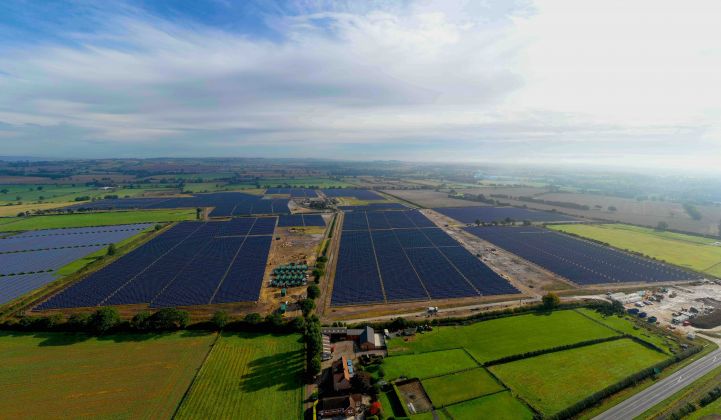U.K. solar developer Gridserve has launched the first of a pair of unsubsidized projects, bringing several new technologies into the country's utility-scale solar market.
The first of the projects, built for a small local authority, Warrington Borough Council, recently went live. The use of bifacial panels (from Suntech), a first for a utility-scale project in the U.K., plus the addition of single-axis trackers (NexTracker), another U.K. first, guaranteed headlines. The 34.7-megawatt solar system is paired with a 30 megawatt-hour battery (from Samsung). The York hybrid project will be entirely merchant.
A second 25.7-megawatt sister project is being developed in Hull and will provide power exclusively for the council’s use. A battery could be retrofitted later down the line. The council is buying both systems for £62.3 million ($81.5 million).
The export/import grid connection means that as well as optimizing the value of power for the solar plant and providing grid services, the battery can also be used, for example, to soak up excess wind power overnight and sell it when the price is right. Energy trading will be handled by a third-party aggregator.
Support for U.K. solar projects over 5 megawatts ended in 2015. The very first contract for difference auction was open to solar but ultimately the program failed to deliver meaningful PV capacity. Energy storage, meanwhile, has seen the market for lucrative grid support services saturate very quickly leaving the project economics for standalone storage very challenging.
Toddington Harper, CEO of the developer Gridserve, said clean energy projects need to do more than generate power if increasingly ambitious climate targets are to be met.
“In order for us to reach net zero, we need build projects that don’t cause the grid problems but actually fix them," Harper told GTM. "We need to make renewables something you can fundamentally rely on and not something that is only there depending on the elements.”
Standalone energy storage has struggled to find a route to market in most of Europe. So Gridserve's use of higher-capex materials such as bifacial modules and single-axis trackers, not to mention that oversized battery, raised eyebrows when announced earlier this year.
Harper says it is the blend of technologies at play that makes the business case stack up.
“From our perspective, we actually look at this as a single project. There's a combination of different technologies, but it's actually the combination of them all together that allows the business case to work. The additional synergy that you get from adding different technologies together is what gives you the extra value that you don't have for each individual technology by itself."
The trackers soften the price cannibalization effect of the U.K.’s solar fleet all hitting peak at the same time. The battery allows for a time-shifting of when the power is delivered, and the bifacial modules mean there’s more solar power to play with in the first place.
With the project successfully financed and delivered, how much have the presence of a local government offtaker and site-specifics impacted the business case?
“I would say it is entirely replicable," Harper said. "That’s probably the most exciting thing about this project for us. To make the economics work, we’ve taken it apart piece by piece. We started out with how much money a [prospective] project has lost from the subsidy being taken away and looked at how we can get that value back.”
Gridserve already has a few more projects in the pipeline, and is hoping to talk to project developers and landowners to build that out further, either by acquiring project rights or developing its own. “Ideally we won’t stop,” said Harper.
Gridserve is also building 100 "Electric Forecourts" in the U.K., a network of high-speed EV chargers. One such site will be directly connected to the York facility, adding yet another layer to an already bulging revenue stack.




